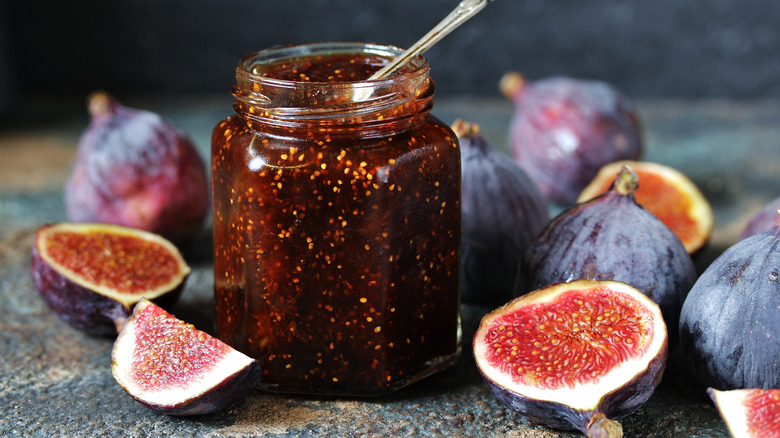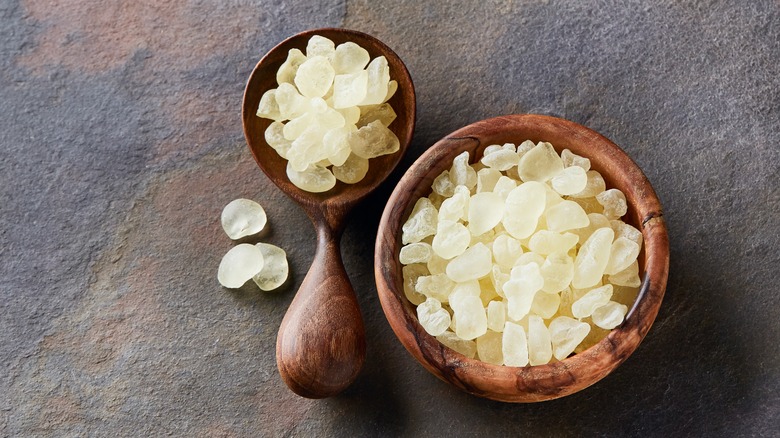Lebanese Fig Marmalade Is A Delicacy Slowly Being Lost To Time
While some people might put a fig spread on a cheese plate, Lebanese fig marmalade has a long storied history that deserves to be rediscovered. Lebanese chef Maradona Youssef spoke to Fine Dining Lovers to express his concern that this classic recipe is slowly being erased from recipe books. Anyone discovering its robust flavors will agree that it's time to enjoy the traditional dish more often.
While Chef Youssef's breakfast offering pairs the fig marmalade with hummus, eggs, yogurt, and other items, he believes that the tradition served in the hearty breakfast is valuable not only nutritionally but culturally. The fig marmalade is a taste from his childhood. By putting it on his menu, not only does he keep his memory alive but also gives others an opportunity to explore a taste of Lebanese culture.
As part of Chef Youssef's breakfast menu, the sweet and savory offering highlights a traditional, culturally relevant recipe. Setting this particular dish apart from others is the nod to traditional ingredients. Speaking about the flavors, Chef Youssef said, "It is a unique, fresh and regenerating recipe that combines and narrates ancient Mediterranean ingredients and flavours such as that of mastice di Chios." Although this recipe is rooted in heritage, it could be time to uncover the classic recipe and its ingredients before they become a distant memory.
What is mastice di Chios and how is it used?
Through his Lebanese fig marmalade, Chef Youssef encourages cooks to rediscover traditional, classic recipes and ingredients. In that particular dish, the fig is paired with mastice di Chios. A traditional ingredient in some Mediterranean dishes, the vegetable resin adds a woody, pine-like flavor to contrast the juiciness of the fig. While not necessarily changing the texture, the combination creates a more nuanced, multi-faceted flavor balance.
Highlighted as an item on the Unesco Intangible Cultural Heritage list, the mastic tree resin has been used as the first chewing gum and some believe consider it a digestive aid. As the "tears" from the tree dry, it is ground and incorporated into various offerings, including baked goods, beverages, and even marmalade.
While not necessarily a common ingredient, the flavor is often described as woody and primarily pine-forward. In a way, it can be slightly more sweet than rosemary, but it maintains its herbal quality. With those characteristics in mind, it can round out other more dominant flavors in a dish.
One common use is the mastiha liqueur. While it had been traditionally used as a digestif after a meal, some chefs and mixologists have showcased the flavor in various dishes and cocktails. Michelin-starred chefs have used it in fish stew and mixologists have been highlighting the alluring aroma of the specialty ingredient.
Classic Lebanese dishes that deserve another taste
As Chef Youssef encourages cooks to rediscover the nuanced flavor of Lebanese fig marmalade, there are numerous classic Lebanese dishes that can join the food conversation. For example, Kanafeh, a sweet cheese pastry, might contrast the nuanced flavor of that fig marmalade. The flaky pastry with orange blossom syrup is quite satisfying.
Building on Chef Youssef's robust breakfast offering, hummus is an approachable, somewhat popular choice that can pair with both sweet and savory items. Whether served with pita, vegetables, or even as a spread on a sandwich, the chickpea, garlic, and tahini blend is quite satisfying.
In addition to other popular sides like rice pilaf, other popular Lebanese dishes include Kafta, fattoush, manakish, and even sfeeha. Although the names might be unfamiliar, the basic food concepts are similar to many dinner-time staples. From a meat pie (sfeeha) to a type of pizza (manakish), these foods create a bridge between cultures. The ingredients might not be the same but the inherent recipes hold a connection. In the end, keeping food culture on the table takes a desire to not only enjoy the flavor but preserve the lineage associated with the dish.


